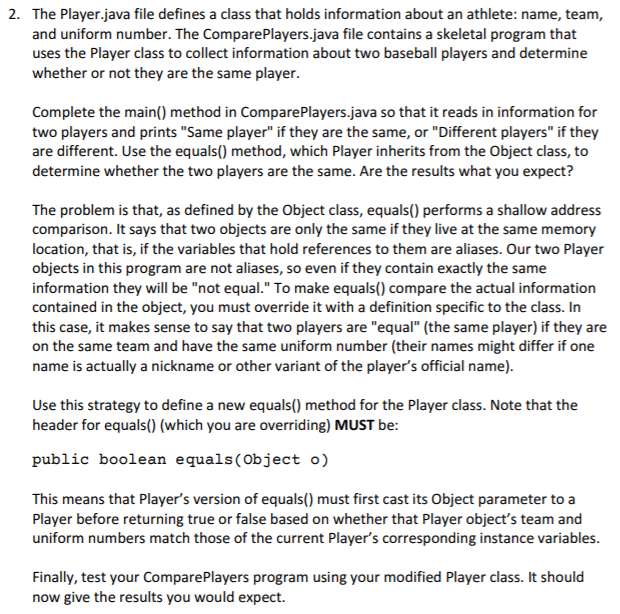Answered step by step
Verified Expert Solution
Question
1 Approved Answer
This program is in JAVA (Player.java and ComparePlayers.java files are below!): // ********************************************************** // Player.java // // Defines a Player class that holds information about
This program is in JAVA (Player.java and ComparePlayers.java files are below!):

// ********************************************************** // Player.java // // Defines a Player class that holds information about an athlete. // ********************************************************** public class Player { private String name; private String team; private int jerseyNumber; //----------------------------------------------------------- // Prompts for and reads in the player's name, team, and // jersey number. //----------------------------------------------------------- public void setName(String name) { } public void setTeam (String team) { } public void setNumber(int number) { } } // ********************************************************** // ComparePlayers // // Reads in two Player objects and tells whether they represent // the same player. // ********************************************************** import java.util.*; public class ComparePlayers { public static void main(String[] args) { Player player1 = new Player(); Player player2 = new Player(); //Prompt for and read in information for player 1 //Prompt for and read in information for player 2 //Compare player1 to player 2 and print a message saying //whether they are equal } } 2. The Player.java file defines a class that holds information about an athlete: name, team, and uniform number. The ComparePlayers.java file contains a skeletal program that uses the Player class to collect information about two baseball players and determine whether or not they are the same player Complete the main() method in ComparePlayers.java so that it reads in information for two players and prints "Same player" if they are the same, or "Different players" if they are different. Use the equals() method, which Player inherits from the Object class, to determine whether the two players are the same. Are the results what you expect? The problem is that, as defined by the Object class, equals) performs a shallow address comparison. It says that two objects are only the same if they live at the same memory location, that is, if the variables that hold references to them are aliases. Our two Player objects in this program are not aliases, so even if they contain exactly the same information they will be "not equal." To make equals) compare the actual information contained in the object, you must override it with a definition specific to the class. In this case, it makes sense to say that two players are "equal" (the same player) if they are on the same team and have the same uniform number (their names might differ if one name is actually a nickname or other variant of the player's official name) Use this strategy to define a new equals() method for the Player class. Note that the header for equals() (which you are overriding) MUST be public boolean equals (Object o) This means that Player's version of equals) must first cast its Object parameter to a Player before returning true or false based on whether that Player object's team and uniform numbers match those of the current Player's corresponding instance variables Finally, test your ComparePlayers program using your modified Player class. It should now give the results you would expect Step by Step Solution
There are 3 Steps involved in it
Step: 1

Get Instant Access to Expert-Tailored Solutions
See step-by-step solutions with expert insights and AI powered tools for academic success
Step: 2

Step: 3

Ace Your Homework with AI
Get the answers you need in no time with our AI-driven, step-by-step assistance
Get Started


